Check Order Status
For immediate assistance, please call 1-866-452-7707
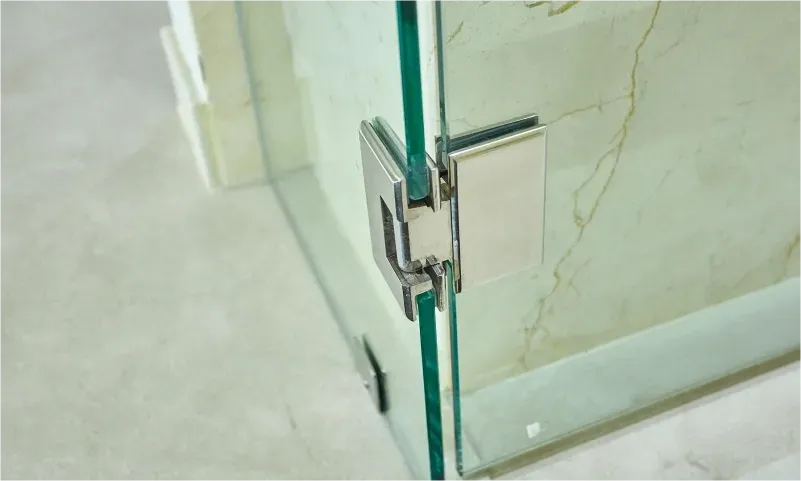

17 Shower Door Design & Construction Tips
We know that any bathroom remodeling project can seem a bit daunting, when choosing the right frameless glass shower door for your enclosure.

Add-On Options for Standard Mirrors
Safety Backing
You can enhance your standard Dulles Glass gym mirrors by adding protective safety backing for only $1.00 per sq. ft. This upgrade acts as a shield against potential hazards and mess, ensuring a safer environment.
Hardware
Our mirror experts ensure a secure wall attachment using mirror mastic, fortified by J-bars or L-bars for peak safety. Opt for decorative clips, standoffs, or rosettes to infuse style.
Cutouts for Wall Openings
Rest assured, even if your space requires strategic cutouts in the mirror glass, we've got you covered. Every gym, studio, or workout area demands precision-cut openings for outlets, vents, wires, TV mounts, and beyond. Our adept Dulles Glass installation team excels at tailoring your gym mirror to flawlessly integrate these elements, ensuring a seamless fit that elevates both functionality and aesthetics.

TIP 01: Angles to Use
You can build your shower using 90°, 135°, or 180° angles. With most shower hardware designed to accommodate these angles, planning your shower installation with this factor in mind will ensure a more cost-effective installation and a properly functioning enclosure.

Enhance Your Space with Flawless Wall-to-Wall Gym Mirror Installations
Unlock a world of sophistication and spaciousness with our expert wall-to-wall mirror installations tailored to businesses within our service area. We specialize in two distinct installation types, ensuring a perfect fit that elevates your environment:

Experience the grandeur of mirrors spanning edge to edge on an entire wall. While offering unparalleled elegance, please note that due to the intricate installation process, this option carries a higher cost.

Elevate your space with mirrors that almost engulf the entire wall, leaving just an inch of space at each edge for a modern and captivating aesthetic.

TIP 02: Support for Shower Doors & Hardware
Be sure the wall on which you would like to install a hinged shower door has proper studding behind it (double 2x4 is best, though single 2x4 is acceptable). Always provide wood studs or blocking where doors hinge or panels are anchored, especially when metal studs were used in the original construction of the wall.

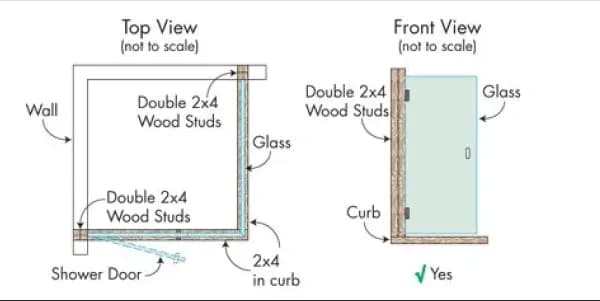

TIP 03: Shower Curb
Decide whether to install your shower enclosure on a curb or to have it flush with the floor. While eliminating the curb is beneficial when planning a handicap accessible shower enclosure, keep in mind that a properly constructed curb helps prevent water from leaking or pooling onto the bathroom floor.

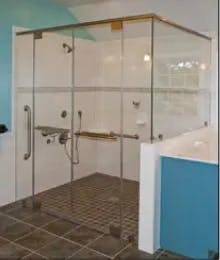
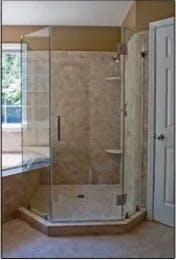

TIP 04: Slope of Curb
The curb or lip around the bottom of the shower should be slanted inward at a 5-degree (approx. 3/16" to 1/4") "pitch" or slope so water flows in toward the drain. (A level curb would cause the water to stand, while a curb angled away from the drain would cause water to leak onto the bathroom floor.



TIP 05: Slope of Shower Seat
Design a built-in shower seat to slant toward the drain at a 5-degree (approx. 3/16" to 1/4") slope, so water flows off the seat and into the drain. (Water will stand on a level seat or pool in a seat with a backward angle.



TIP 06: Plumb Walls
Walls that meet a door or glass panel need to be completely vertical, or "plumb", to prevent gaps, uneven joints, and hinge "bind". This means the wall can't lean in any direction, or be "bowed" or "bellied". Any walls that are more than 1/4" out of plumb make it very difficult to install a shower properly because they cause unsightly gaps, are more likely to leak and have a greater likelihood of hinge bind. About 75 percent of the homes we work in do not have perfectly straight walls, so this is a common problem that we're very good at handling. For less than 1/4" out of plumb walls, we will cut the glass so it will lie flush against your wall.




TIP 07: Minimum Width of Glass Panels
When designing your shower enclosure, keep in mind that each glass panel needs to be at least 4 1/2" wide, which is the minimum width for tempering glass and supporting the hardware. Also, the door will need to be a minimum of 22" wide and no more than 36" wide.





TIP 08: Glass Tiles
Avoid mounting door hinges and glass clips onto glass tiles, as breakage is likely to occur during and even after installation. This can result in delays in getting the project finished and additional charges from the tile installers for repairs.

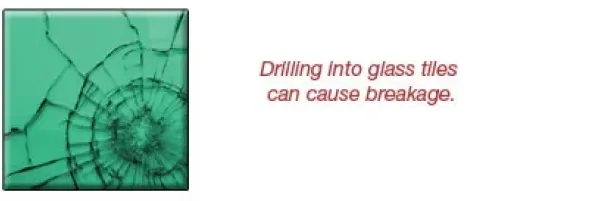

TIP 09: Soffits
The "soffits" or eaves along the top of the shower enclosure must line up perfectly with the angles in the curb below in order to avoid an uneven look.

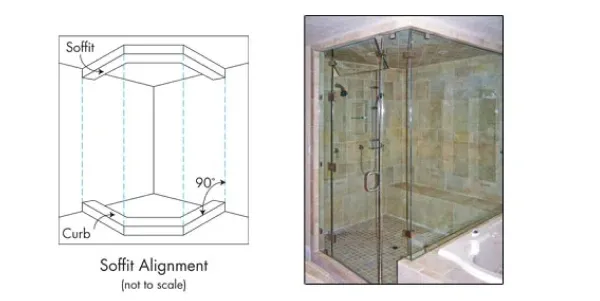

TIP 10: Shower Head Position
To minimize leakage, position showerheads toward tiled walls or fixed panels. Showerheads should never be positioned opposite a door or other opening. (Exceptions may be made for smaller or low-flow showerheads or showerheads that point straight down at the floor.)



TIP 11: Raised Tiles and Overhangs
Shower doors should be installed in such a way that nothing interferes with their movement and there are no gaps between the door and the wall. Environments that interfere with door movement are raised decorative tiles and overhanging tiles, and granite or marble slabs atop a shower seat or buttress wall. The tile or granite can be modified to allow for door operation, but a filler might need to be applied, negatively impacting the look of the finished product.



A better solution is to include a fixed panel in your design. That way, the door can align with the panel on one side, opening and closing properly with no interference. On the other side, the tile can be notched to allow the panel to line up flush against the wall.



TIP 12 Curb Tops
Keep in mind that solid pieces of tile, marble or granite are best for the top of a curb. Tiled curb tops increase the likelihood of leakage and encourage the growth of mold or mildew because water collects in grout joints on horizontal tiles. The shower door seal functions best on a smooth surface.

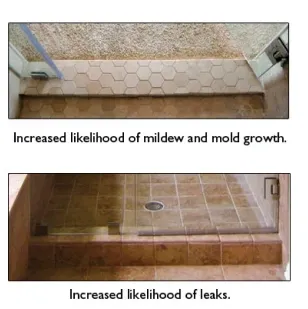
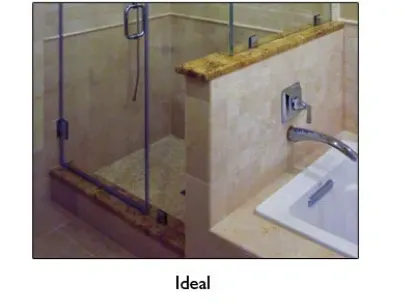

TIP 13 Pipes and Wiring
Never run plumbing pipe or electrical wiring through walls or studs where an anchoring screw for the shower enclosure hardware might puncture it



TIP 14 Knee Walls
When designing an enclosure that has a buttress or "knee" wall, plan on including an in-line panel in your design. That way, you can modify the fixed panel to accommodate the buttress wall instead of trying to modify the door.


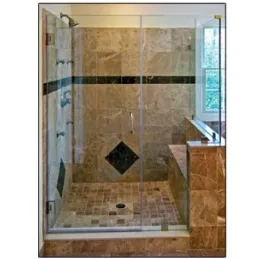

TIP 15 Shower Door Swing
When planning your shower design, keep in mind that Building Code Requirement IRC P 2708.1 (2000 edition) states that all hinged shower doors must open outwards. Hinged shower doors that swing inwards only are not permitted by code.
There are reasons this code is in place. The shower enclosure must permit unobstructed access to a showering person in case of a fall.
However, your shower door can open in both directions, outward-opening and inward-swinging. You'll need about 30" of clearance space outside your shower to install a swinging shower door.
If your bathroom is not configured for a shower door, consider choosing a sliding shower door . Your other alternatives include double sliding doors, which come either semi-frameless or framed, and a shower screen which leaves ample clearance space in case of an emergency.


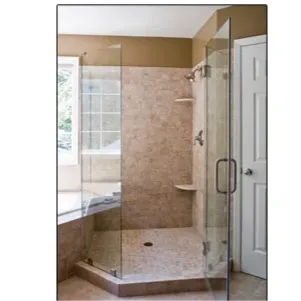

TIP 16 Transoms
A glass transom is located above a frameless glass shower door. It can be fixed or movable. There are several reasons to use a glass transom:
- Venting steam showers: Steam showers must run floor-to-ceiling for an airtight construction so steam can accumulate. Instead of bringing the door all the way to the ceiling, most steam showers are designed with movable transoms above the door. The glass transom then acts like a vent and can be tilted open to release hot steam or kept close to keep the steam in. You'll want to make sure you have a tile ceiling rather than drywall for this application.
- Stabilizing tall floor-to-ceiling showers: Homeowners who want a floor-to-ceiling frameless shower may need a glass transom in their design. The need depends on ceiling height and weight limit of the shower door.
- Installing pivot doors: Pivot doors that don't run floor-to-ceiling can mount to a header or a glass transom. Homeowners who would like to avoid the framed look of a header may find a solution by revising their design to incorporate a glass transom. We will help you get the best shower configuration for the look you want.
You'll want to make sure the door won't be hampered by anything installed on the ceiling when it swings open. If an exhaust fan, vent or light fixture is placed in the path of the swinging door, a transom may be required to give the door clearance.


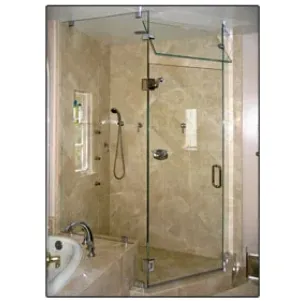

TIP 17 Neo Angle Shower
If your neo angle shower enclosure includes a "knee" wall or wall, make sure that the shower door meets the structure at a 90 degree angle to accommodate the requirements of the hinges. This is not a restriction when glass meets glass at the 135 degree angle.



Our customers say
Excellent
4.9 out of 5 stars
Dulles Glass
Company
Support

Learn more about our:
Price Match Guarantee
United States © 2025 Dulles Glass. All Rights Reserved.

